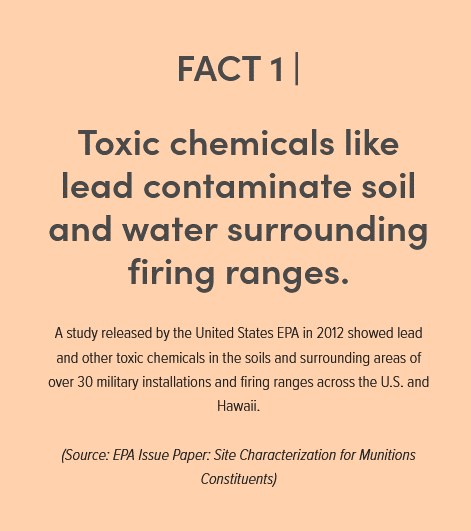For a PDF copy of NGLA Facts, click here.
LEAD CONTAMINATION OF OUR DRINKING WATER AND COASTLINE
THE NORTHERN GUAM LENS AQUIFER (NGLA) is a critical resource that provides our island community with 85% of its fresh drinking water.
The U.S. military is building a massive firing range complex over the NGLA. Up to 6.7 million lead bullets will be fired over our aquifer and coastline each year. (Source: Final SEIS, p 2-10)
5 REASONS WHY THIS PUTS OUR COMMUNITY AT RISK
FACT 1 | Toxic chemicals like lead contaminate soil and water surrounding firing ranges.
A study released by the United States EPA in 2012 showed lead and other toxic chemicals in the soils and surrounding areas of over 30 military installations and firing ranges across the U.S. and Hawaii. (Source: EPA Issue Paper: Site Characterization for Munitions Constituents)
Fact 2 | Chemicals from firing range activities can travel (via surface or groundwater)
…to both groundwater (what we drink and bathe in) AND coastal waters and contaminate coastal and marine resources.
"The results (of the study) show that there is a wide range of chemicals that are left in soil—many of which can be mobilized by rain and travel to groundwater. This is a particular concern because the karst limestone geology of the islands is relatively porous." (Source: Jim Keany, former director of Environmental Science Associates, environmental consulting firm)
FACT 3 | This isn't just a theory. Just last month, lead levels up to 70 times the accepted residential level were found on a beach in Oahu adjacent to a range training facility.
A recent crisis of lead contamination is unfolding now as lead levels up to 70 times the accepted residential levels have been found on a public beach adjacent to the Puualoa Range Training Facility in Oahu. (Source: https://www.hawaiinewsnow.com/2022/10/05/nonprofit-calls-navy-address-high-lead-contamination-waters-off-ewa-beach/)
FACt 4 | Multiple agencies have raised water contamination issues.
In agency comments on the SEIS, one of the concerns raised by the Department of Interior was of potential lead groundwater contamination. (Source: Draft SEIS, Appendix G, 603)
FACT 5 | National law requires the Navy to produce and Environmental Impact Statement or EIS.
In this document, the Navy omitted relevant data (like the EIS paper) and did not provide plans for mitigation if contamination occurs. The EIS or document required of the Navy by National law to show environmental impacts of the range complex that is being constructed over our only aquifer
omitted relevant data and does not discuss or identify all chemicals and propellants to be used at the ranges.
does not account for changes or impacts to groundwater flow from future water well pumping and installations, resource demands, and climate change.
makes no plans for mitigation if either the aquifer or coastline is contaminated.





